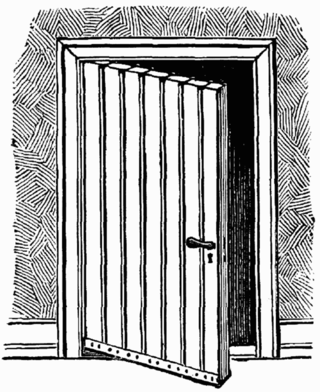
A door is a hinged or otherwise movable barrier that allows ingress (entry) into and egress (exit) from an enclosure. The created opening in the wall is a doorway or portal. A door's essential and primary purpose is to provide security by controlling access to the doorway (portal). Conventionally, it is a panel that fits into the doorway of a building, room, or vehicle. Doors are generally made of a material suited to the door's task. They are commonly attached by hinges, but can move by other means, such as slides or counterbalancing.
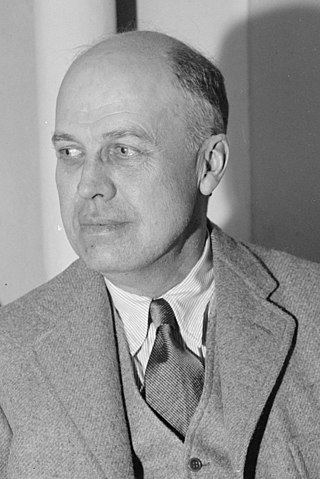
Edward Hopper was an American realist painter and printmaker. He is one of America's most renowned artists and known for his skill in capturing American life and landscapes through his art.
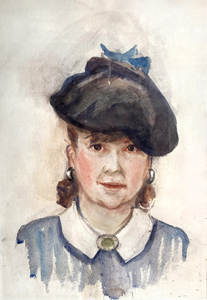
Josephine "Jo" Verstille Hopper was an American painter who studied under Robert Henri and Kenneth Hayes Miller, and won the Huntington Hartford Foundation fellowship.

Grace Cossington Smith was an Australian artist and pioneer of modernist painting in Australia and was instrumental in introducing Post-Impressionism to her home country. Examples of her work are held by every major gallery in Australia.

Nighthawks is a 1942 oil-on-canvas painting by the American artist Edward Hopper that portrays four people in a downtown diner late at night as viewed through the diner's large glass window. The light coming from the diner illuminates a darkened and deserted urban streetscape.
High Noon is a 1952 western film directed by Fred Zinnemann.

Woman in a Dressing Gown is a 1957 British drama film directed by J. Lee Thompson and starring Yvonne Mitchell, Anthony Quayle, Sylvia Syms, and Carole Lesley.

Chop Suey (1929) is an oil painting on canvas by the American artist Edward Hopper. The foreground of the work portrays two women in conversation at a restaurant. In November 2018, it was sold at $92 million, a record price for the artist's work.

Automat is a 1927 oil painting by the American realist painter Edward Hopper. The painting was first displayed on Valentine's Day 1927 at the opening of Hopper's second solo show, at the Rehn Galleries in New York City. By April it had been sold for $1,200. The painting is today owned by the Des Moines Art Center, in Iowa.
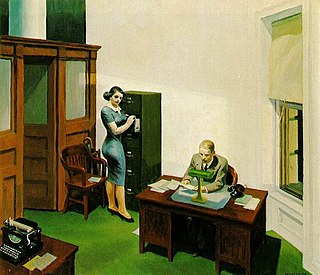
Office at Night is a 1940 oil-on-canvas painting by the American realist painter Edward Hopper. It is owned by the Walker Art Center in Minneapolis, Minnesota, which purchased it in 1948.

Nude is a black and white photograph taken by Edward Weston in 1936. It shows an apparently nude woman with her arms wrapped around her legs while she sits on a blanket in bright sunlight against a darkened doorway. The dynamic balance of the light and dark accentuate the curves and angles of the woman's body; at the same time her face and all but the slightest hint of her pubic area are hidden from view, requiring the viewer to concentrate on her arms, legs, feet and hands. It is an image of a nude that concentrates solely on the forms of the body rather than the sexuality. The model was his muse and assistant, Charis Wilson, whom he married a year later.

Hotel Lobby is a 1943 oil painting on canvas by American realist painter Edward Hopper; it is held in the collection of the Indianapolis Museum of Art (IMA), in Indianapolis, Indiana, United States.

East Wind Over Weehawken is a 1934 oil painting on canvas by American realist painter Edward Hopper. It was held in the collection of the Pennsylvania Academy of Fine Arts in the United States from 1952 until its sale to an anonymous buyer in December 2013. That sale brought a record price for a Hopper.
Donna Dennis is an American sculptor, painter, and printmaker. She is one of a small group of groundbreaking women, including Alice Aycock, Jackie Ferrara and Mary Miss, who pushed sculpture toward the domain of architecture in the early 1970s. “When Donna Dennis created her earnest, plain-spoken Tourist Cabins at the outset of her career,” writes Deborah Everett in Sculpture Magazine, “they had the impact of cultural icons.” Drawing from overlooked fragments of rural and urban vernacular American architecture—tourist cabins, hotels, subway stations, roller coasters—Dennis represents stopping places on the journey through life.
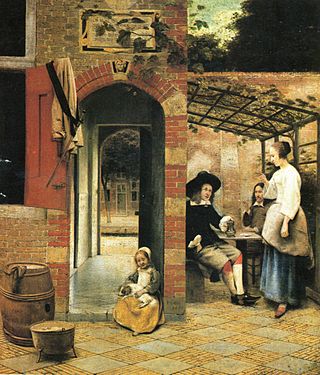
Courtyard with an Arbour (1658–1660) is an oil-on-canvas painting by the Dutch painter Pieter de Hooch; it is now in a private collection. It was sold in 1992 for almost seven million dollars.

Alice Dalton Brown is an American painter known for realist works that capture the light and texture of specific, if often invented, places and moments. Her signature motifs include exteriors of Victorian houses, barns and waterscapes viewed through windows or sheer curtains, by which she explores the play of light, shadow, reflection and geometry across various surfaces. Critic J. Bowyer Bell wrote of Dalton Brown's style, "her realist works are more than the sum of their parts. In fact, there are so many parts so cunningly included, so many skills on display, that the result is almost an encyclopedia of what can be done."
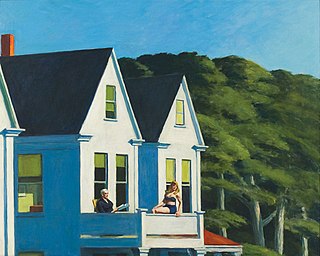
Second Story Sunlight is a 1960 oil painting by the American artist Edward Hopper. It depicts two women of different ages on the second-story balcony of a white house. The older woman reads a newspaper while the younger woman sits on the railing. It is in the collections of the Whitney Museum of American Art, in New York.
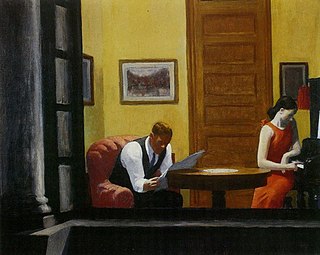
Room in New York is a 1932 oil-on-canvas painting by the American artist Edward Hopper that portrays two individuals in a New York City flat. It is held in the collection of the Sheldon Museum of Art. The painting is said to have been inspired by the glimpses of lighted interiors seen by the artist near the district where he lived in Washington Square.

Sun in an Empty Room is a 1963 painting by American realist Edward Hopper (1882–1967). It is a late period painting completed at his Cape Cod summer home and studio in South Truro, Massachusetts, just four years before his death at age 84. The work depicts a room, seemingly empty, except for light coming through a window, reflecting along the walls and floor. Leaves on a tree or bush can be seen just outside the window.
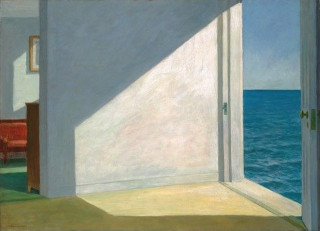
Rooms by the Sea is a 1951 painting by American realist Edward Hopper. It is a late period painting completed in the fall at his Cape Cod summer home and studio in South Truro, Massachusetts. The work depicts an empty room with a door opening to the sea, letting sunlight into that room and another room behind it. It is the first of two paintings with the shared theme of an empty room without people but filled with light, followed by Sun in an Empty Room (1963). Although Hopper adamantly rejected the characterization, art critics have noted elements of abstract art and surrealism in the work.


















